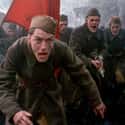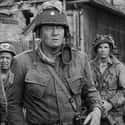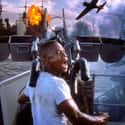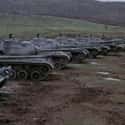-
(#5) Battles Involving Millions Of Soldiers Completely Depend On The Fortune Of One Or Two Characters
The Trope: Though an entire world war may rage on around them, the actions of one protagonist soldier, and perhaps a couple of key supporting characters, are all that stands between their nation and total defeat.
Why Is It Inaccurate?: Millions upon millions of men and women fought in WWII, and though many distinguished themselves with their singular bravery, battles never depended on the doings of a single person. The most egregious abuser of this trope is Enemy at the Gates, a film based on the breathless memoir of Soviet sniper Vasily Zaitsev, played by Jude Law. It reads:
Kulikov fires off a blind shot. We have to arouse the sniper's interest. We decide to sit out the first half of the day; light reflecting from the scopes could give us away. In the afternoon our rifles are in the shade while the direct light of the sun falls upon the German's position.
Something sparkles by the edge of the sheet. Is this a piece of glass that just happens to be there, or is the telescopic sight of a sniper's rifle?As the movie and Zaitsev himself seem to imply, nearly the entirety of the siege of Stalingrad hinged on a one-on-one sniper duel between him and his counterpart, Major Konig, whom the German high command had dispatched for the express purpose of neutralizing Zaitsev. In reality, the duel almost certainly never happened, Konig probably didn’t even exist, and the events at Stalingrad were far broader and more complex than Hollywood and its love of exceptional men would have you believe.
Notable Offenders: Enemy at the Gates, The Great Escape, Fury
-
(#12) The Axis Side Suffered Way More Casualties Than The Allies
The Trope: Though you’re obviously supposed to care more about deaths on the Allied side in Hollywood WWII movies, they’re far less frequent than the demises of those aligned with the Axis, who regularly get mowed down in waves yet never seem to stop coming. Which seems to make sense, given that they did lose and all.
Why Is It Inaccurate?: Far more military casualties occurred on the Allied side than on the Axis. The Soviet Union alone, with its estimated 7.5 million dead, lost more soldiers than Germany, Japan, and Italy combined. China suffered almost double the losses Japan did. This is another trope that clearly views the conflict through an American lens, as the US "only" suffered 405,399 dead and another 670,846 wounded.
Notable Offenders: Midway, Inglorious Basterds
-
(#8) D-Day Was A Lightning-Quick, Over-And-Done Affair
The Trope: The invasion of German-occupied Europe that took place on D-Day only took a single day, and appears to have been doable in the span of a single motion picture. After all, it’s D-Day, not D-Week, right?
Why Is It Inaccurate?: The Battle of Normandy was an enormous undertaking, and it took an appropriately enormous amount of time. With the invasion beginning at 6:30 am on June 6, 1944, the Allies had landed more than 156,000 troops and established several beachheads by the day’s end - but the work was far from complete. The beaches of Normandy would not be fully secure until June 11, five days later. Films like to portray D-Day as an uphill battle of an hour or two at most, after which the Americans punched through the enemy fortifications and were ready to roll across France, but the truth is much lengthier.
Notable Offenders: Saving Private Ryan, Patton, and, somewhat ironically, The Longest Day
-
(#2) PG-13 Films Can Accurately Portray The Carnage
The Trope: In any PG-13 WWII flick, there may be a little death and destruction, but only of the family-friendly variety. A soldier may perish, but usually only from a single gunshot wound that produces little blood and allows him enough time to squeeze in a quick soliloquy.
Why Is It Inaccurate?: War is hell, the kind of hell that can only be replicated by the hardest of R-ratings. Though gunfire undoubtedly produced far more gruesome injuries than those seen on the big screen, the grisliest scenes were often the result of artillery and mortar fire, which could reduce an entire human being to a fine red mist.
If a film were to accurately portray the true, ceaseless carnage of WWII, it would turn the stomach of most audience members, as it did for many of those who had to witness it firsthand. Take Quentin Aanenson’s recollections, for instance:
It was on one of my early missions that I knew I had, I’d killed men..We caught a group of Germans that were on a road in an area where there were no trees. And I remember the impact it had on me when I could see my bullets just tearing into them. That was my job. This is what I’d been trained to do, and I dealt with it fine. But when I got back home to the base in Normandy and landed I got sick. I had to think about what I had done. Now that didn’t change my resolve. I went out and did it again. And again and again and again.
Notable Offenders: Pearl Harbor is probably the worst offender, but it’s actually easier to list those few films that come close to capturing the carnage, like Hacksaw Ridge and Saving Private Ryan.
-
(#13) Everything Important In The War Was Done By Americans
The Trope: If there’s one thing that Hollywood serves to reinforce, it’s that America won WWII more-or-less singlehandedly, with only the occasional assist from someone with a British accent for the sake of variety.
Why Is It Inaccurate?: Not only did America not even join the war effort until December of 1941, when it had been raging for over two years, they were far from the solitary supplier of soldiers to the Allied cause - nor were they the largest. That honor goes to the Soviet Union, who had an estimated 12.5 million people in service at their peak, just edging out the US’s 12,364,000 (and total Soviet casualties were far, far higher than America's). Millions more fought alongside the Allies from nations like India, Canada, Australia, and the Philippines.
Occasionally, American-made films will even go as far as to insert Americans into WWII stories that have nothing to do with them. Such is the case of U-571, which insinuates it was the US - and not, as it actually was, Britain - that captured the Enigma code machine from a German U-boat. At the time of its release, British Prime Minister Tony Blair called the film an “affront.”
Another prominent example The Great Escape, took the 76 real Allied soldiers - from nations as diverse as Norway and the Netherlands - and replaced them with Americans like Steve McQueen. In reality, all of the real-life Americans involved in the breakout from Stalag Luft III had been transferred to another facility before the plan was hatched.
Notable Offenders: U-571, The Great Escape, The Pacific
-
(#4) Two Clear Sides Square Off Perfectly, With Little Confusion Over Who's Who
The Trope: WWII battles appear to have been fought in much the same fashion as every other historical era of combat as portrayed on film, with two clearly distinct sides facing off against one another on a nice, neatly defined battleground.
Why Is It Inaccurate?: Even with its predominance of trench warfare, even WWI didn’t truly match the above description most of the time, and the sequel was an entirely different experience altogether. WWII saw soldiers fighting in all manner of terrain and without always having the benefits of nice and neat battlelines. As such, chaos often reigned, as supply officer John Higgins recalled:
The confusion in the jungle you have to experience. It's hard to believe that two infantry battalions could blunder into each other unless you were there in the jungle where you couldn't see, you know, 10 feet in front of you.
Further evidence of that notion is given by the sheer number of fatal friendly fire incidents that took place in WWII, including mistakes that left hundreds of Allies dead at a time. As if that weren’t confusing and chaotic enough, Germans were even known to occasionally sneak behind Allied lines in stolen uniforms to wreak havoc, further blurring the fog of combat.
Notable Offenders: Battle of the Bulge, Enemy at the Gates, Windtalkers
New Random Displays Display All By Ranking
About This Tool
Our data comes from Ranker, If you want to participate in the ranking of items displayed on this page, please click here.











